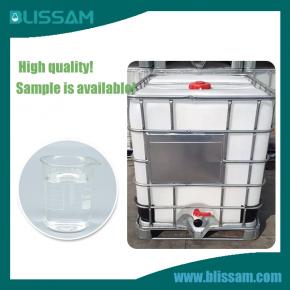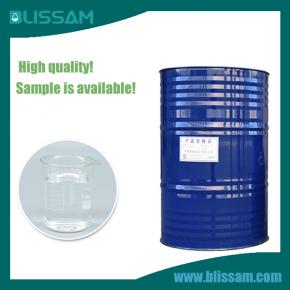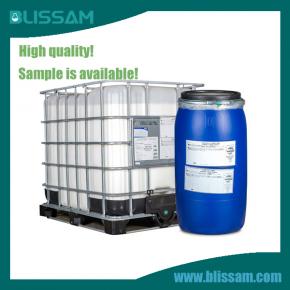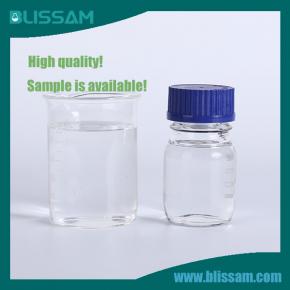BLISSAM is a leading manufacturer and supplier of high-quality silicone fluids. our company has years of experience in the industry and has continuously strived to provide innovative and reliable silicone products to customers all over the world.we offer a wide range of silicone fluids for various applications in different industries. Our products are carefully developed and tested to ensure the highest level of quality and performance. We offer both standard and customized solutions to meet the specific needs of our customers.
Our silicone fluids can be used as lubricants, sealants, and anti-foaming agents in the automotive industry. They are also commonly used in the manufacturing of electronics to enhance thermal management and improve insulation properties. In the cosmetics industry, our silicone fluids are used to improve the texture and spreadability of products. In the construction industry, they are used as water repellents and in the formulation of sealants and adhesives.
At Silicone Fluids, we are committed to providing our customers with the best quality products. Our manufacturing process follows strict quality control standards to ensure that our products are consistent and meet the highest industry standards. We also conduct regular testing and analysis to continuously improve our products and meet the evolving needs of our customers.
In addition to our high-quality products, we also strive to provide exceptional customer service. Our team of experienced professionals is dedicated to understanding our customers' needs and providing them with the best solutions and support.
Introducing our revolutionary Silicone Fluids products, designed to provide exceptional performance and versatility for a wide range of applications. Our Silicone Fluids offer outstanding thermal stability, low viscosity, and excellent compatibility with a variety of materials. With a wide range of viscosities and formulations available, our Silicone Fluids are suitable for use in various industries including cosmetics, pharmaceuticals, and automotive. Experience the difference with our high-quality Silicone Fluids, and see how they can enhance your products and processes. Trust us to bring you the best in silicone technology for all your needs.

Silicone fluids, also known as silicone oils, are a type of synthetic polymer fluid that is commonly used in various industries due to its unique properties. These fluids are composed mainly of silicon atoms and oxygen atoms, giving them a characteristic flexibility and heat resistance. They are available in a wide range of viscosities, making them suitable for a variety of applications including lubrication, release agents, and coatings. With their low surface tension and non-toxic nature, silicone fluids are also commonly used in the cosmetic and personal care industry. In addition, they are highly stable and have excellent electrical insulation properties, making them suitable for use in electronic devices. Overall, silicone fluids offer a versatile and efficient solution for many different industries and applications.
1.What are the environmental concerns related to the use of silicone fluids?
2.How are silicone fluids used in the production of electronic components and devices?
3.What are the chemical reactions and processes involved in the production of silicone fluids?
4.What is the future trend in the development of silicone fluids for new and emerging technologies?
5.What is the shelf life of silicone fluids and how can it be extended?
6.What are the advantages and disadvantages of using silicone fluids in electrical insulation?
7.How do silicone fluids improve the durability and longevity of building materials?
8.What role do silicone fluids play in the manufacturing of rubber and plastic products?
9.What techniques are used to analyze and measure the different physical and chemical properties of silicone fluids?
1.What are the environmental concerns related to the use of silicone fluids?
1. Non-biodegradable: Silicone fluids are non-biodegradable, meaning they do not break down naturally in the environment. This can lead to long-term accumulation and potential harm to ecosystems. 2. Persistence in the environment: Due to their chemical structure, silicone fluids can persist in the environment for a long time, leading to potential long-term exposure and accumulation in living organisms. 3. Toxicity to aquatic life: Some silicone fluids have been found to be toxic to aquatic life, such as fish and other aquatic organisms. This can disrupt the balance of aquatic ecosystems and harm the organisms that rely on them. 4. Potential for bioaccumulation: Silicone fluids have the potential to bioaccumulate in living organisms, meaning they can build up in the tissues of animals and plants over time. This can lead to harmful effects on the organisms and those that consume them. 5. Contamination of water sources: The use of silicone fluids in industries such as agriculture and manufacturing can lead to contamination of water sources, either through direct release or runoff. This can have negative impacts on the quality of drinking water and aquatic ecosystems. 6. Production and disposal: The production of silicone fluids involves the use of energy and resources, which can contribute to carbon emissions and other environmental impacts. Improper disposal of silicone fluids can also lead to pollution of land and water. 7. Potential health risks: Some silicone fluids have been linked to potential health risks, such as skin irritation and respiratory issues. This can be a concern for workers who are exposed to these fluids during production or use. 8. Impact on wildlife: The use of silicone fluids in products such as personal care items and household cleaners can lead to accidental exposure of wildlife, which can have negative effects on their health and behavior. 9. Disruption of natural processes: The presence of silicone fluids in the environment can disrupt natural processes, such as the breakdown of organic matter by microorganisms. This can have cascading effects on the entire ecosystem. 10. Lack of regulation: There is currently limited regulation on the use and disposal of silicone fluids, which can lead to improper handling and potential environmental harm.
2.How are silicone fluids used in the production of electronic components and devices?
Silicone fluids, also known as silicone oils, are used in the production of electronic components and devices in various ways. Some of the common uses of silicone fluids in the electronics industry include: 1. Lubrication: Silicone fluids are used as lubricants in the production of electronic components such as switches, connectors, and relays. They help reduce friction and wear between moving parts, ensuring smooth operation and longer lifespan of the components. 2. Thermal management: Silicone fluids have excellent thermal conductivity and can dissipate heat efficiently. They are used in the production of electronic devices such as computer chips, LED lights, and power supplies to help regulate and dissipate heat, preventing overheating and damage. 3. Insulation: Silicone fluids have high dielectric strength, making them ideal for use as insulating materials in electronic components and devices. They are used to coat and protect sensitive electronic parts from electrical currents and moisture. 4. Adhesives and sealants: Silicone fluids are used as adhesives and sealants in the production of electronic devices. They provide a strong bond between different components and help seal out moisture and contaminants, ensuring the longevity and reliability of the devices. 5. Mold release agents: Silicone fluids are used as mold release agents in the production of plastic and rubber components for electronic devices. They help prevent sticking and facilitate easy removal of the molded parts from the molds. 6. Cleaning agents: Silicone fluids are used as cleaning agents in the production of electronic components. They help remove dust, dirt, and other contaminants from sensitive electronic parts without damaging them. Overall, silicone fluids play a crucial role in the production of electronic components and devices, ensuring their smooth operation, longevity, and reliability.

3.What are the chemical reactions and processes involved in the production of silicone fluids?
The production of silicone fluids involves several chemical reactions and processes, including: 1. Hydrolysis: The first step in the production of silicone fluids is the hydrolysis of silicon metal or silicon tetrachloride (SiCl4) in the presence of water. This reaction produces silanol (Si-OH) groups, which are the building blocks of silicone fluids. 2. Polymerization: The silanol groups produced in the hydrolysis step then undergo a condensation reaction, where they combine to form longer chains of siloxane (Si-O-Si) units. This process is known as polymerization and is typically catalyzed by acids or bases. 3. Distillation: The resulting polymer is then distilled to remove any impurities and to control the molecular weight of the silicone fluid. This step is crucial in determining the physical properties of the final product. 4. Functionalization: To modify the properties of the silicone fluid, functional groups such as methyl, phenyl, or vinyl can be added to the siloxane backbone through a variety of chemical reactions. This process is known as functionalization and allows for the customization of silicone fluids for specific applications. 5. Emulsification: In some cases, silicone fluids are emulsified with water to form stable oil-in-water emulsions. This process involves the addition of surfactants and emulsifiers to the silicone fluid, which helps to disperse the oil droplets in water. 6. Cross-linking: Cross-linking is a process where the siloxane chains are linked together to form a three-dimensional network. This can be achieved through the addition of cross-linking agents or by exposing the silicone fluid to high temperatures or radiation. Cross-linking can improve the physical properties of silicone fluids, making them more resistant to heat, chemicals, and mechanical stress. 7. End-capping: End-capping is a process where the silanol groups at the ends of the siloxane chains are reacted with functional groups to prevent further polymerization. This helps to control the molecular weight and viscosity of the silicone fluid. 8. Purification: The final step in the production of silicone fluids is purification, where the product is filtered and treated to remove any remaining impurities. This ensures that the silicone fluid meets the required purity standards for its intended use. Overall, the production of silicone fluids involves a series of chemical reactions and processes that can be tailored to produce a wide range of products with different properties
4.What is the future trend in the development of silicone fluids for new and emerging technologies?
The future trend in the development of silicone fluids for new and emerging technologies is expected to focus on enhancing their properties and expanding their applications in various industries. Some of the key developments that are likely to shape the future of silicone fluids include: 1. Increased demand for high-performance and sustainable materials: With the growing focus on sustainability and environmental concerns, there is a rising demand for high-performance and sustainable materials. Silicone fluids, with their unique properties such as high thermal stability, low toxicity, and biocompatibility, are well-positioned to meet this demand. As a result, there is likely to be a significant increase in the development of new and improved silicone fluids that offer enhanced performance and are more environmentally friendly. 2. Advancements in nanotechnology: The use of silicone fluids in nanotechnology is expected to increase in the coming years. These fluids have the ability to form stable dispersions with nanoparticles, making them ideal for use in various applications such as coatings, adhesives, and electronics. As nanotechnology continues to advance, there will be a growing need for specialized silicone fluids that can meet the unique requirements of this field. 3. Growing demand for silicone fluids in the healthcare industry: Silicone fluids have a wide range of applications in the healthcare industry, including in medical devices, drug delivery systems, and personal care products. With the increasing demand for advanced healthcare solutions, there is likely to be a significant growth in the development of silicone fluids that are specifically designed for use in the healthcare sector. 4. Expansion of applications in the automotive industry: Silicone fluids are widely used in the automotive industry for various applications such as lubrication, damping, and sealing. With the growing demand for electric and autonomous vehicles, there will be a need for specialized silicone fluids that can meet the unique requirements of these vehicles. This is expected to drive the development of new and improved silicone fluids for the automotive industry. 5. Integration with other emerging technologies: Silicone fluids are also expected to play a crucial role in the development of other emerging technologies such as 3D printing, flexible electronics, and energy storage systems. As these technologies continue to evolve, there will be a need for specialized silicone fluids that can enable their efficient functioning. Overall, the future of silicone fluids is likely to be driven by the increasing demand for high-performance and sustainable materials, advancements in nanotechnology, and their expanding applications in various industries. With ongoing research and development, we can expect to see the emergence of new and innovative silicone fluids that will continue to

5.What is the shelf life of silicone fluids and how can it be extended?
The shelf life of silicone fluids can vary depending on the specific type and grade of the fluid. Generally, silicone fluids have a shelf life of 2-3 years when stored in their original, unopened containers at room temperature. However, this can be extended by following proper storage and handling guidelines. To extend the shelf life of silicone fluids, it is important to store them in a cool, dry place away from direct sunlight and sources of heat. Exposure to extreme temperatures can cause the fluid to degrade and lose its effectiveness. It is also important to keep the containers tightly sealed to prevent contamination. Additionally, it is recommended to use the oldest stock of silicone fluid first to ensure that it does not expire before it can be used. Regularly checking the expiration date and rotating stock can also help to ensure that the fluid is used before it expires. If the silicone fluid has been opened and partially used, it is important to properly reseal the container to prevent contamination and degradation. Some silicone fluids may also require special handling and storage instructions, so it is important to follow the manufacturer's recommendations. In summary, the shelf life of silicone fluids can be extended by storing them properly, using the oldest stock first, and following the manufacturer's instructions for handling and storage.
6.What are the advantages and disadvantages of using silicone fluids in electrical insulation?
Advantages: 1. High dielectric strength: Silicone fluids have a high dielectric strength, making them an effective insulator for electrical equipment. 2. Wide temperature range: Silicone fluids can withstand a wide range of temperatures, from -50°C to 200°C, making them suitable for use in both high and low-temperature applications. 3. Chemical resistance: Silicone fluids are resistant to many chemicals, including acids, bases, and solvents, making them suitable for use in harsh environments. 4. Low flammability: Silicone fluids have a low flammability, making them safer to use in electrical equipment. 5. Good thermal stability: Silicone fluids have good thermal stability, meaning they can withstand high temperatures without breaking down or losing their insulating properties. 6. Low viscosity: Silicone fluids have a low viscosity, making them easy to apply and allowing them to penetrate small gaps and crevices in electrical equipment. Disadvantages: 1. High cost: Silicone fluids can be more expensive than other types of insulating fluids, making them less cost-effective for some applications. 2. Low flash point: While silicone fluids have a low flammability, they also have a low flash point, meaning they can ignite at relatively low temperatures. 3. Poor compatibility with some materials: Silicone fluids may not be compatible with certain materials, such as some types of rubber, which can cause swelling or degradation. 4. Limited shelf life: Silicone fluids have a limited shelf life and can degrade over time, especially when exposed to high temperatures. 5. Difficult to remove: Silicone fluids can be difficult to remove from electrical equipment once they have been applied, which can make maintenance and repairs more challenging. 6. Environmental concerns: Some silicone fluids may contain harmful chemicals that can be harmful to the environment if not disposed of properly.

7.How do silicone fluids improve the durability and longevity of building materials?
Silicone fluids, also known as silicone oils or silicone polymers, are synthetic compounds that are widely used in the construction industry. They are known for their excellent thermal stability, chemical resistance, and low surface tension, making them ideal for a variety of applications in building materials. Here are some ways in which silicone fluids improve the durability and longevity of building materials: 1. Water and weather resistance: Silicone fluids are highly water-repellent and have excellent resistance to weathering, making them ideal for use in building materials that are exposed to harsh environmental conditions. They can prevent water from penetrating into the material, which can cause damage and deterioration over time. 2. UV resistance: Silicone fluids have excellent UV resistance, which means they can withstand prolonged exposure to sunlight without degrading or breaking down. This makes them ideal for use in building materials that are exposed to direct sunlight, such as roofing materials, window seals, and exterior coatings. 3. Chemical resistance: Silicone fluids are highly resistant to a wide range of chemicals, including acids, alkalis, and solvents. This makes them ideal for use in building materials that may come into contact with these substances, such as sealants, adhesives, and coatings. 4. Thermal stability: Silicone fluids have a high thermal stability, which means they can withstand extreme temperatures without breaking down or losing their properties. This makes them ideal for use in building materials that are exposed to high temperatures, such as fire-resistant coatings and insulation materials. 5. Flexibility and elasticity: Silicone fluids have a high degree of flexibility and elasticity, which allows them to withstand movement and stress without cracking or breaking. This makes them ideal for use in building materials that are subject to movement, such as sealants and adhesives. 6. Mold and mildew resistance: Silicone fluids have anti-fungal properties, which make them resistant to mold and mildew growth. This is particularly beneficial in building materials that are exposed to moisture, such as bathroom and kitchen sealants. 7. Durability: Due to their excellent resistance to various environmental factors, silicone fluids can significantly improve the durability and longevity of building materials. They can help prevent damage and deterioration, thereby extending the lifespan of the materials. In conclusion, silicone fluids offer a wide range of benefits that can improve the durability and longevity of building materials. Their unique properties make them a popular choice in the construction industry, and they are used in various applications to enhance the performance and lifespan of building materials.
8.What role do silicone fluids play in the manufacturing of rubber and plastic products?
Silicone fluids, also known as silicone oils, are commonly used in the manufacturing of rubber and plastic products for their unique properties and benefits. Some of the roles they play include:
1. Lubrication: Silicone fluids have excellent lubricating properties, making them ideal for use in rubber and plastic processing equipment. They help reduce friction and prevent sticking, which can improve the efficiency of the manufacturing process.
2. Mold release agent: Silicone fluids are often used as mold release agents in the production of rubber and plastic products. They create a thin, non-stick layer between the mold and the product, making it easier to remove the product from the mold without damaging it.
3. Surface treatment: Silicone fluids can be used as surface treatment agents to improve the appearance and feel of rubber and plastic products. They can provide a glossy or matte finish, as well as enhance the softness and smoothness of the surface.
4. Anti-foaming agent: In rubber and plastic processing, air bubbles can form and cause defects in the final product. Silicone fluids are effective anti-foaming agents that can prevent the formation of bubbles and improve the quality of the end product.
5. Thermal stability: Silicone fluids have high thermal stability, meaning they can withstand high temperatures without breaking down. This makes them suitable for use in the production of rubber and plastic products that require heat treatment or exposure to high temperatures.
6. Chemical resistance: Silicone fluids are highly resistant to chemicals, including acids, bases, and solvents. This makes them useful in the production of rubber and plastic products that will come into contact with various chemicals.
7. Electrical insulation: Silicone fluids have excellent electrical insulation properties, making them suitable for use in the production of electrical components and devices made of rubber and plastic.
Overall, silicone fluids play a crucial role in the manufacturing of rubber and plastic products by providing lubrication, mold release, surface treatment, anti-foaming, thermal stability, chemical resistance, and electrical insulation.
9.What techniques are used to analyze and measure the different physical and chemical properties of silicone fluids?
1. Viscosity Measurement: Viscosity is a key physical property of silicone fluids that can be measured using various techniques such as rotational viscometry, capillary viscometry, and falling ball viscometry. 2. Density Measurement: The density of silicone fluids can be measured using techniques such as pycnometer method, hydrostatic weighing, and gas pycnometry. 3. Refractive Index Measurement: Refractive index is an important optical property of silicone fluids that can be measured using techniques such as Abbe refractometry, refractometry, and ellipsometry. 4. Thermal Analysis: Thermal properties of silicone fluids such as melting point, glass transition temperature, and thermal stability can be analyzed using techniques such as differential scanning calorimetry (DSC), thermogravimetric analysis (TGA), and thermal conductivity measurement. 5. Spectroscopic Analysis: Infrared (IR) and nuclear magnetic resonance (NMR) spectroscopy are commonly used techniques to analyze the chemical structure and composition of silicone fluids. 6. Gas Chromatography (GC): GC is a powerful analytical technique used to separate and identify the individual components of a silicone fluid mixture. 7. Mass Spectrometry (MS): MS is a highly sensitive technique that can be used to determine the molecular weight and structure of silicone fluids. 8. Surface Tension Measurement: Surface tension is an important physical property of silicone fluids that can be measured using techniques such as pendant drop method, Wilhelmy plate method, and du Nouy ring method. 9. Rheological Analysis: Rheological properties of silicone fluids, such as shear stress and shear rate, can be measured using techniques such as rotational rheometry and oscillatory rheometry. 10. Particle Size Analysis: Particle size distribution of silicone fluids can be determined using techniques such as laser diffraction, dynamic light scattering, and sedimentation analysis.
Contact:
Phone: +86-15957191858
E-mail: info@blissam.com
Whatsapp:+8615957191858
Add: A647, No. 9, Xiyuan Road, Xihu District, Hangzhou, Zhejiang, China
We chat
